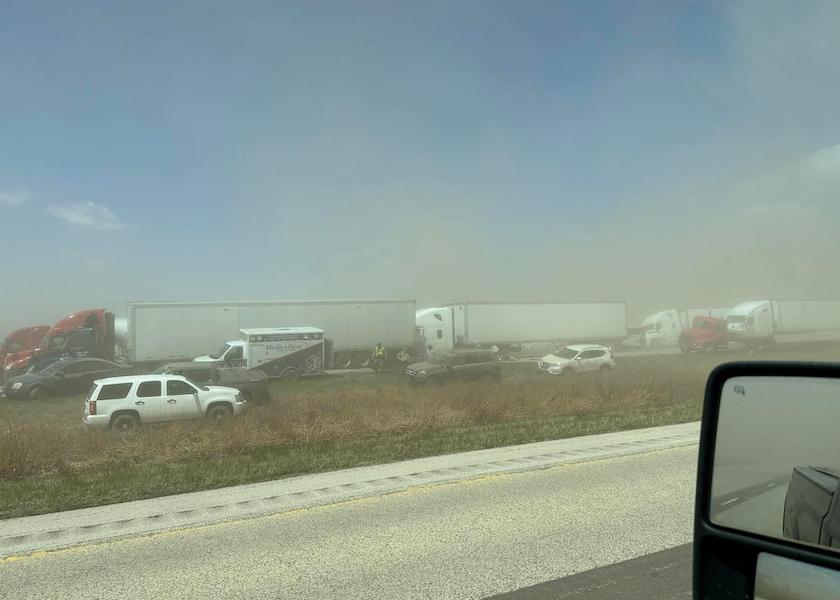Digging Into the Culprit of the Rare and Unusual Illinois Dust Storm

A dust storm in Illinois on Monday caused a 72-car pile-up along I-55. Multiple fatalities were also reported. The Illinois State Police said Monday the pileups were caused by "excessive winds blowing dirt from farm fields across the highway, resulting in zero visibility."
The interstate remained shut down until Tuesday morning. Officials said the first crash was reported at 10:55 a.m. Monday in the northbound lanes near Milepost 76, just south of Springfield.
And this is partly why I am starting to support mandatory conservation practices in exchange for accepting any and all taxpayer subsidies. If we farmers want public support we need to provide public goods AND services! https://t.co/SAqBpH4Nrg — Paul Overby (@VerdiPlus) May 1, 2023
As more details came to light Tuesday, some reports blamed “freshly plowed fields and gusty winds” as the culprit of the dust storm. There were even calls for support for mandatory conservation practices.
News reporting the Illinois incident as a pileup from a dust storm…I think it should be reported as a pileup from ag pollution. — GOTILLA (@SoMN_Stripper) May 2, 2023
USDA meteorologist Brad Rippey says dust storms in the Midwest are unusual. But he says the incident in Illinois was sparked by the combination of bare soils in the spring, 55-plus mile per-hour winds and the direction of those winds coming across the highway. He called it an unfortunate “perfect storm,” and one that more than likely wasn’t preventable.
“Even in perfect conditions you can get and you know perfect practices, you can still get a situation where you have a very short window. If topsoil is dry, they can still blow,” says Rippey. “So, I think it was a really unfortunate collision of events that happened yesterday between the strong storm, the angle of the wind, the condition of the fields and the dryness over the last month. There may be no way to really prevent that, and it's just a real tragedy. Hopefully, it's a one-off and we won't see anything else like this this spring.”
Rippey says he’s seen an explosion of cover crop use over the past decade. And while he doesn’t know the exact practices adopted on the fields that experienced the dirt to pick up and blow, he says there can still be a window of time between when some of the cover crops are sprayed and when summer crops emerge and start to canopy.
Rippey attributes the following factors to the unusual dust storm in Illinois Monday:
- Westerly to northwesterly winds (45 to 55+ mph) generated by a stalled low-pressure system over the Great Lakes were nearly perpendicular to a major highway (I-55).
- Those high winds crossed agricultural fields before reaching I-55, leading to a narrow streamer of blowing dust and abrupt reductions in visibility.
- Topsoil was primed to be lofted into the air by short-term dryness – April rainfall in the area totaled about 2 inches, roughly half of normal.
- Fields were tilled for planting or had just been planted, leaving topsoil exposed (until a crop canopy forms in a few weeks). By April 30, corn planting was 40% complete in Illinois, soybeans were 39% planted.
“I suspect that some of these fields that blew yesterday had already been planted, we just didn't have any emergence, or canopy establishment at this point,” says Rippey. “The topsoil, which is that thin layer right on top, is still exposed to the blowing wind.”
Rippey points out that the other factor is how dry portions of Central Illinois have been over the past month.
“If you look at Central and Southern Illinois, we've only seen about two inches of rain over the last month. That's about half normal, and it left conditions just dry enough where that thin layer of topsoil can be lofted by the wind, which unfortunately reached 55 miles per hour, and took it right across a major highway,” says Rippey.
He points out that other weather events—like snow and heavy rainfall—are not an uncommon cause of accidents in the eastern U.S. However, rarely does that part of the country see blowing dirt.
“It usually has to happen just in that short window in the spring, when fields are exposed, open and bear, and then have that high wind blowing across it at the perfect angle,” says Rippey.
He says where the threat is still high is in the Plains. Even with the recent rains, extreme drought and high winds are still a concern.







